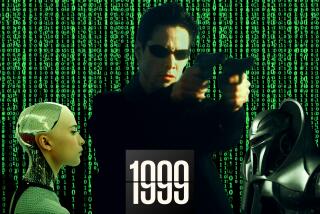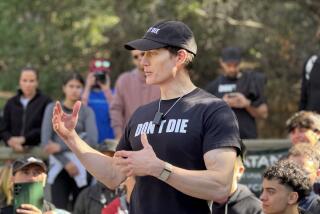Human meaning in a world of ones and zeroes
In July 2001, Michael Chorost, a writer and researcher at SRI International, a Silicon Valley research center, became deaf after a viral illness. That fall, he became a cyborg. “I can feel the compact bulk of the implant in my skull,” Chorost writes about the surgery. “It is strange to think that by now its two computer chips will have warmed up to exactly the temperature of my body.”
Chorost’s hearing had been impaired since childhood. When he was 36, while on a business trip to Nevada, he noticed that both his hearing aids were failing. Nothing he did -- a change of batteries, adjusting ear molds and tubes -- made a difference. In a local emergency room, a specialist told him what was happening to his hearing. “I’ve always been hard of hearing. I can’t go deaf,” he thought.
In a normally functioning ear, sound waves are translated into electrical impulses by thousands of tiny hairs in the cochlea, a spiral organ linking the ear to the brain. The hairs in Chorost’s cochleas no longer functioned, but the nerves that connected them to the brain were undamaged. Thus, he was a candidate for a cochlear implant, an electronic device that digitally processes sounds and transmits them to 16 electrodes connected to the cochlear nerves.
“Rebuilt: How Becoming Part Computer Made Me More Human” is Chorost’s account of learning to hear again. Funny and thoughtful, the book is an extended meditation on the nature of perception, the human brain and the relationship between technology and humanity.
The term “cyborg” is familiar from science fiction. Think of TV’s Steve Austin, “the bionic man,” or characters on “Star Trek.” Some even use the term when referring to any combination of humans and machines: By this standard, someone wearing glasses or even using a toothbrush is a cyborg. Wrong, Chorost argues: To be a cyborg, you need technology that “exerts control of some kind over the body.” In his case, the cochlear implant mediates between him and the world of sound; he hears through a tangle of silicon, wire and code.
The implant is the size and thickness of two quarters: Packed into its ceramic casing are a microprocessor, a radio transmitter and a magnet that externally attach to a headpiece worn by Chorost. An insulated wire from the microprocessor is threaded into the cochlea. “The computer’s playing my ear,” he writes about the time it was first activated. Sixteen electrodes don’t produce the same signals that thousands of hairs do. Autumn leaves tinkle rather than crunch. Leaf blowers and toilets sound like explosions. And the implant seems to make little distinction between sounds that are near and far. Chorost must learn to interpret the new signals.
Some of this learning is conscious: Conversations are easier if he doesn’t concentrate too hard on them. Much of it happens at the neural level, as Chorost’s brain learns to associate new signals with familiar sounds like friends’ voices or the rustling of paper. Male and female voices at first sound the same, muffled and indistinct. But then they begin to sound different; eventually, “male voices sounded deep” once more and “women sounded like women again.” What happened?
“My brain had somehow reinterpreted a huge frequency change back into a semblance of normality,” he explains.
Incredibly, the implant uses two software programs to control the electrodes, which interpret sound in very different ways. One program makes the world sound “big, blocky and fuzzy,” he writes, while the other makes the world sound quiet, metallic and tinny. Different programs produce different auditory worlds, and different realities.
“My hearing had not been restored,” he writes. “It had been replaced, with an entirely new system that had entirely new rules.... I would have to become emotionally open to what I heard, instead of fighting against it.”
The challenge of making human meaning in a world of zeroes and ones colors other parts of Chorost’s life too, including his attitude toward technology. He signs up for online dating services but finds that the reduction of people to a set of formal coordinates -- height, eye color, profession -- may suggest precise matchmaking when it actually short-circuits the slow, serendipitous processes that normally bring and bind people together. (Ellen Ullman’s classic memoir, “Close to the Machine: Technophilia and Its Discontents,” also describes the effect of technological obsession on private passion.)
In one brilliant passage, Chorost notes that “[s]ocial norms are not taught, they are overheard, but the one thing even the most skilled deaf people cannot do is overhear.” And yet, the deaf community in America is a group whose “warmth, intimacy, and cohesiveness ... are legendary,” and whose members have turned American Sign Language into a remarkably expressive medium. (Chorost was never quite part of that world: He responded to hearing aids, and his parents were determined to raise him in the hearing world rather than have him learn to sign.) Cochlear implants are available to many young deaf children today. Those who get them won’t hear perfectly but they probably won’t learn enough sign language to be full members of the deaf community: In other words, they’ll be like Chorost. In the long run, the author fears, cochlear implants will probably spell the deaf community’s end -- yet another community whose bonds will be weakened, or destroyed, by technology.
Four years after getting the implant, Chorost has decamped suburban Silicon Valley for urban San Francisco, and he continues his search for the ideal mate. He also hears pretty well. But even more important, as he reflects on the equipment and the software that runs it, he says, “my bionic hearing made me more human, because I was constantly aware that my perception of the universe was provisional, the result of human decisions that would be revised time and again. [I]t was my task as a human being to strive to connect ever more complexly and deeply with the people and places of my life.”
“Rebuilt” may be the first of a new genre: the cyborg memoir. It certainly won’t be the last. Every era has its characteristic trials and transformations. Thanks to a blend of demographics and technological advance, we can expect an avalanche of stories of transformations that are equal parts technological, neurological and social. Futurist Theodore Roszak argues in “Longevity Revolution” that aging baby boomers will embrace a stunning variety of implants and genetic modifications to remain healthy and independent.
Medical advances are improving formerly life-threatening medical conditions brought on by advancing age or injury. What was once a rare or easily marginalized experience may become a rite of passage as millions of us, entering our last decades, learn to walk, see or hear again. The challenge will not just be to recover but to draw what wisdom we can from the experience.
Chorost shows us the way. His awareness of life’s fragility, gained after making a determined effort to overcome its challenges, strikes me as the perfect answer to opponents of implants and genetic modification who worry about the effect of such tinkerings on our selves and souls. Memoirs such as “Rebuilt” will be invaluable guides in this new territory. *






